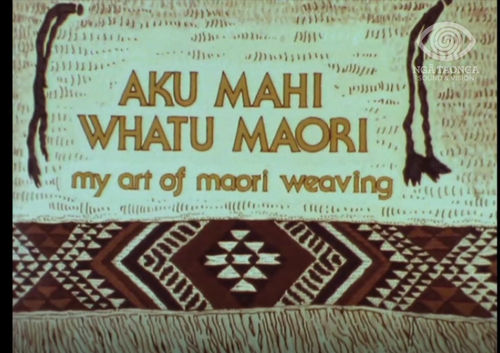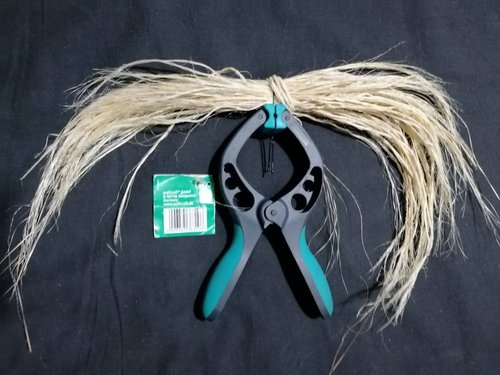
Ko te manu e kai ana i te miro, nōnā te ngahere. Ko te manu e kai ana i te mātauranga nōnā te ao.
The bird that consumes the miro berry reigns in the forest. The bird that consumes knowledge has access to the world.
In May 2021 I started weaving again. I saw an ad at the local church and joined up to one night a week. I had done a weaving course back in 2011, so I was keen to rekindle my relationship with flax.
As I work at Ngā Taonga, I naturally wondered what we had in our collection to do with mahi raranga and how it might be different to other lessons I’ve had.
When I last studied raranga, it was at Te Wānanga O Aotearoa, and I was lucky to learn under several talented kaiako. I was introduced to many books written about mahi raranga. We even coordinated a class order to purchase a book that was out of publication. I am the proud owner of a copy of Raranga Whakairo by Mick Prendergast, a book with over 200 raranga patterns. I have moved house twice since then, and my copy of this precious book is somewhere. I am sure it will turn up.
Different ways of learning
Audio-visual resources like those in the Ngā Taonga collection have some extra benefits for learners, inexperienced weavers, and those of us that cannot remember where we put our stuff!
Audio-visual resources are easily accessible, inexpensive, and easy to use. Most people have access to a computer and the internet. Times, days, and location of in-person classes have many restrictions, whereas online resources can be accessed when it suits you. Audio-visual learning is accurate and motivating: a learner can use tutorials and stop, go, and repeat as they wish. This can be particularly helpful if you have a learning or hearing impediment – you can learn at a pace and volume that works best.
You can also experience processes that you have only been told of or read about and had to visualise in your mind. Film demonstrations can show things more effectively than words. I found this when watching my most favourite clip in the collection: Aku Mahi Whatu Māori. My Art of Māori Weaving. This 1978 documentary is always in the top ten most-watched items in our collection – it is a favourite of many people.
Extracting muka and learning more
As part of my previous learnings, I heard about extracting muka – the internal strands or fibres in a blade of harakeke. The muka is washed, beaten, and rubbed to soften and whiten the fibre, and well-prepared muka is soft and silky. I have only extracted small tufts of muka, which I plaited together to make handles for my kete (bag). My muka felt a bit stiff and scratchy, so I always wondered what the washing, beating, and rubbing was like. I could not imagine such a process, as the muka felt so delicate and fragile during extraction. To my astonishment in Aku Mahi Whatu Māori. My Art of Māori Weaving, the great queen of weaving,Dame Rangimarie Hetet, demonstrates what to do.

A picture of my efforts. The clamp is a small hand-sized clamp and this tuft of muka made one handle (you need two for a kete).
In the film we see a group of learners with Dame Rangimarie and her daughter, Rangituatahi Te Kanawa. They look like they are out the back of the house. Dame Rangimarie places a huge, neatly twisted handful of muka on a large flat stone and beats it with a club-shaped stone several times. Those watching get splashed with soapy water from the force of the muka being hit. She mentions that she added some ‘Bio-Louva’ soap to help bleach the muka. Any of you oldies remember that brand of soap? Its vaguely familiar, and if I remember right, it was my nan’s generic word for all soaps and cleaners. In my classes we were told to use ‘Sunlight’ soap in solid bar form. I was surprised you could still buy it! I would never have imagined the power and technique used in this process if I had not watched this film.Skip to 8 minutes into the film to watch this part of the process.

A screenshot from from Aku Mahi Whatu Maori.
Finding raranga in the collection
The amount of mātauranga raranga (weaving knowledge) in our collection is vast and precious. He puna mātauranga raranga kei ā tātou kohinga taonga nei.
I was inspired to learn more and there have been many shows over the years that have captured the old ways and the nannies weaving. Programmes like Te Karere, Waka Huia, Koha and Kahurangi took the time to listen to the stories and show the methods. I’m grateful these are in the collection and can be shared with future generations. These shows and others capture Correspondence School tutorials, wānanga and conference recordings, radio interviews, and documentaries about the people, places and communities that are involved in mahi raranga.
After watching Aku Mahi Whatu Māori, I did more research in our catalogue. There are different raranga terms and some items overlapped into several categories. Others did not show up where I expected. My advice to researchers is to search as many terms as you can think of. I searched Māori kupu related to mahi raranga, like raranga, harakeke, kete and toi Māori. Then I searched using the English equivalents terms too.
My favourite clip Aku Mahi Whatu Māori did not show up in my ‘raranga’ or ‘flax’ searches but came up with other search terms because of the words in the title. Sometimes you’ve got to have a bit of a look to find the good stuff.
Even though not all the titles are available to watch on our website, I enjoyed seeing a full list of items in our collection. I was able to look up some of these titles on other sites like NZ on Screen. They have Weekly Review No. 280 – Patterns in Flax from 1947 which shows a more industrial approach to weaving.
A surprise benefit of searching our collection was finding non-Māori weaving related titles. This sparked my interest to investigate New Zealand and international weaving, and weaving around the world and the similarities and shared techniques in different culture’s weaving. You could say I accidently tripped down the worldwide weaving rabbit hole.
Our Archive is inspirational – both personally and professionally. It has inspired me to keep practicing my muka extraction. It has inspired me to research more of the art and history of raranga. It makes me feel proud of Māori arts and Māori artists. It makes me proud of our mahi we do here at the Archive and our people who work here now and, in the past.
Hero image: Title screen from Aku Mahi Whatu Maori – My Art of Maori Weaving.